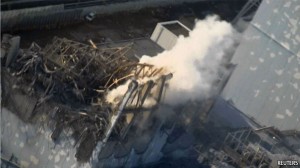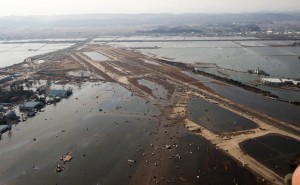By Urmimala Shome   e-mail: sango83@gmail.com
 Editor’s Note: Born in Kolkata, India, Urmimala Shome came to Pittsburgh, PA, when her parents moved to Pittsburgh, over 25 years ago. She was five years old. She grew up in Pittsburgh earned her mechanical engineering degree from Carnegie Mellon, and is working in the commercial nuclear power industry since June 2005. After working as an Accident Analyst at Westinghouse Electric for five years she moved to Mitsubishi Heavy Industries (MHI) last year as a Severe Accident Analyst. She was in Japan on work when the quake hit. She lives in Arlington, VA.
Editor’s Note: Born in Kolkata, India, Urmimala Shome came to Pittsburgh, PA, when her parents moved to Pittsburgh, over 25 years ago. She was five years old. She grew up in Pittsburgh earned her mechanical engineering degree from Carnegie Mellon, and is working in the commercial nuclear power industry since June 2005. After working as an Accident Analyst at Westinghouse Electric for five years she moved to Mitsubishi Heavy Industries (MHI) last year as a Severe Accident Analyst. She was in Japan on work when the quake hit. She lives in Arlington, VA.
I was at work when the quake hit. I was jotting down some mundane project schedule reminder when, all of a sudden I started to feel dizzy and nauseous. Then I noticed the window blinds swaying back and forth like a pendulum. “Ah, my first Japan earthquake,†I thought. My first international quake really, as I had lived through several smaller ones during my short stay in California. Several minutes passed. I began to realize that the rocking motion (like ones on a boat in choppy weather) had not subsided or reduced in intensity. Most of my Japanese teammates were congregating at the windows and peering out at the ocean. At the time of the quake, I was working out of Kobe, a port city on the Pacific Coast, located in southwestern Japan. Mitsubishi’s Energy & Transportation Division is located at the MHI Shipping yard, right next to the ocean.
 About five whole minutes passed since I first noticed the first sign of a quake. During those minutes, I had been giving a play-by-play of the situation to friends back in California via g-chat. I immediately went on the USGS.org site, reading about the time, location, and magnitude of the quake. Preliminary readings put it at 7.9 on the U.S. Richter scale, the epicenter approximately 900 km (~560 miles) northeast of Kobe. The final reading placed it at a 9.0.
About five whole minutes passed since I first noticed the first sign of a quake. During those minutes, I had been giving a play-by-play of the situation to friends back in California via g-chat. I immediately went on the USGS.org site, reading about the time, location, and magnitude of the quake. Preliminary readings put it at 7.9 on the U.S. Richter scale, the epicenter approximately 900 km (~560 miles) northeast of Kobe. The final reading placed it at a 9.0.
Japanese zoning and construction laws are strict about building on earthquake-prone  sites. Modern buildings are designed to sway during a quake, and absorb the kinetic energy of the moving ground. Your sways and the displacements you experience depends on how far you are above the ground, on what floor you are on – the higher you are, the more sway you will feel. My group is located on the eighth floor of a 12-story building, so we definitely felt our building rock back and forth.
sites. Modern buildings are designed to sway during a quake, and absorb the kinetic energy of the moving ground. Your sways and the displacements you experience depends on how far you are above the ground, on what floor you are on – the higher you are, the more sway you will feel. My group is located on the eighth floor of a 12-story building, so we definitely felt our building rock back and forth.
 Soon after the initial quake stopped, the aftershocks started; two were almost as severe lasting almost as long as the initial tremor. Since the epicenter was out in the sea, Kobe was at risk of being hit by a tsunami. About ten minutes after the end of the second aftershock, we were told to evacuate in response to a tsunami warning. But Kobe was spared  any tsunami effects.
Soon after the initial quake stopped, the aftershocks started; two were almost as severe lasting almost as long as the initial tremor. Since the epicenter was out in the sea, Kobe was at risk of being hit by a tsunami. About ten minutes after the end of the second aftershock, we were told to evacuate in response to a tsunami warning. But Kobe was spared  any tsunami effects.
For a entire week after March 11th, I was on the phone, e-mailing, and Skyping with family and friends trying to reassure them of my safety. I initially did not plan to return to the U.S., but decided to do visit my family who were understandably worried sick.Â
Throughout this week, news coverage of the Fukushima Daiichi nuclear plant situation was in full swing. Working in the commercial nuclear power industry for the past six years, of course, gave me better understanding into the technical aspects of the accident in the four reactors. It was interesting for me to see how the situation was explained to the public.
There was a definite contrast between Japanese and American reporting. Watching CNN that first night, I was rather disappointed with the lack of accurate reporting in the U.S. I soon turned CNN off and started reading Al Jazeera, BBC, World Nuclear News, and the NRC sites online. I soon instructed my family and friends to follow suit.Â
American news programs sensationalized about 90% of their coverage of Fukushima. Instead of trying to explain basic principles of how nuclear energy is generated or even the layout of the inside of these types of reactors, reporters felt the need to politicize the future of nuclear power in general by comparing the accident to Chernobyl and Three Mile Island. They were falsely claiming that Fukushima was “another Chernobyl,†which is not only inaccurate, but also unethical because that comparison propagated rampant misinformation. Instead of calm, collected, and objective journalism, the American public was misinformed with anti-nuclear energy rhetoric and propaganda. The Japanese reporting was more objective. Specifically, the NHK news anchors kept table-top models of the inside of the Fukushima reactor to help explain the phenomenon inside the plant. They interviewed the electric utility company officials who owned the reactor as well as the civilians impacted by the evacuation. In the first weeks after the quake, NHK reporters focused on trying to be as informative as possible, without commenting on the politics of Japan’s nuclear power.Â
Outside of the news coverage, I was rather impressed by the level of calm and preparedness shown by the Japanese people. Their response was one of seasoned veterans facing yet another natural disaster. Of course, this quake was singularly worse because the huge quake was coupled with tsunami, which destroyed a nuclear plant, leading to radiation exposure.Â
Had something of this magnitude happened anywhere else in the world, especially in the U.S., it is entirely possible that we would have had much more mass panic and disorder. The aftermath of Hurricane Katrina provides a good example. The widespread looting during Katrina was starkly different from the dignified and respectful way that the Japanese people treated one another. There seemed to be a real sense of community and camaraderie from the very start in the wake of the great calamity.
As a result of this level of cooperation, the impacted region of Japan is now steadily recovering. However, the question remains, what is the fate of nuclear power in Japan and rest of the world? There are many lessons to be learned from Fukushima. The worldwide nuclear community must be given the opportunity to apply those lessons learned to new plan construction.
It is clear that the much-lauded “nuclear renaissance†can no longer go full-steam ahead. Already, all of the world’s nuclear reactors are being inspected again, and have been either modified or shut down as a result.
There is no doubt that the accidents at Fukushima have shaken people’s confidence in nuclear power. Going forward, it is the responsibility of the nuclear industry to convince the public that nuclear power is safe, and still has a future in our world. So we are taking it one day at a time. n
